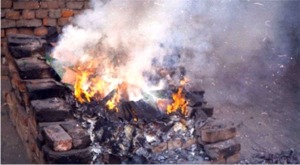E-waste is a collective name for discarded electronic devices that enter the waste stream. Of the entire e-waste generated, computer waste poses significant environmental and health hazards. The changing lifestyle of people, coupled with urbanisation, has lead to increasing rates of consumption of electronic products. This has made electronic waste management an issue of environment and health concern. The dumping of e-waste, particularly computer waste, into India from developed countries because the latter find it convenient and economical to export waste has further complicated the problems associated with waste management.
In terms of production, internal consumption and electronics export industries have emerged as the fastest growing segment of Indian industry. In the last five years (1995-2000), the Indian IT industry has recorded a CAGR (Compounded Annual Growth Rate) of more than 42.4 per cent, which is almost double the growth rate of IT industries in many of the developed countries. In the IT action plan, the government has targeted to increase the present level of penetration, from 5 per 500 people to 1 for 50 people, by 2008. This envisages applying IT in every walk of the economic and social life of the country.
When compared to the USA, the Indian configuration of 5 PCs per 500 people does not represent any sign of massive rise in PCs obsolescence rate. But of the nearly 5 million PCs in India, 1.38 million are either 486s or below. This figure represents a vast amount of equipment soon to be added to the waste stream as upgradation beyond a point becomes uneconomical and incompatible with software in demand. In any case, this invisibility has started blurring with the huge import of junk computers that, in turn, create ugly situations for solid waste management in India. The biggest source of PC scrap are foreign countries that export huge quantities of computer waste in the form of monitors, printers, keyboards, CPUs, typewriters, PVC wires, etc.
 After separating all remaining components, motherboards are put for open pit burning to extract the thin layer of copper foils laminated in the circuit board.
After separating all remaining components, motherboards are put for open pit burning to extract the thin layer of copper foils laminated in the circuit board.
In India, most of the recyclers currently engaged in recycling activities do not have this expensive technology to handle the waste. Computer scrap is managed through various management alternatives such as product reuse, conventional disposal in landfills, incineration and recycling. However, the disposal and recycling of computer waste in the country has become a serious problem since the methods of disposal are very rudimentary and pose grave environmental and health hazards. In addition, besides handling its own computer waste, India now also has to manage the waste being dumped by other countries. Solid waste management, which is already a mammoth task in India, has become more complicated by the invasion of e-waste, particularly computer waste.
The import of hazardous waste into India is actually prohibited by a 1997 Supreme Court directive, which reflects the Basel Ban. The developed world, however, finds it more convenient and also economical to export e-waste to the third world countries like India, rather than managing and incurring high environmental and economic cost. Primary investigations carried out for Basel Action Network revealed that indigenous as well as imported computer waste has lead to the emergence of a thriving market of computer waste products and processing units for material recovery in different parts of India. So trade in e-waste is camouflaged and is a thriving business in India, conducted under the pretext of obtaining reusable equipment or donations from developed nations.
Highly toxic chemicals found in the different components of computer parts can contaminate soil, groundwater and air, as well as affect the workers of the unit and the community living around it. Moreover, the workers in computer waste recycling operations may face dangerous working conditions where health and environmental conditions are compromised. Hence there is a clear reason to be concerned about the trade, the technology in practice and the existing poor disposal practices of computer waste in India.
The management of electronic waste has to be assessed in the broad framework of Extended Producer Responsibility and the Precautionary Principle, so that future policies can be made more responsive in addressing this issue. At present, management options for e-waste are extremely polluting and hence are of grave concern. This problem has assumed a global dimension, of which India is an integral and affected part. Interventions to check the polluting systems of recycling and give viable options for better management of computer waste can best be suggested only after as assessment is done.
Against this backdrop, New Delhi based Toxics Link (an environmental non-government organization and the authors of this article) conducted a study to bridge the gap in understanding and knowledge of the computer scraps trade and its reprocessing technology. The study looked at the market, the nature and present practice of reprocessing of computer waste components and government policies for e-waste management. Due to the growing computer waste, the use of hazardous chemicals in the production process, the intricacies involved in the recycling process, and illegal dumping in India, the report focussed on computer waste. It further gives recommendations in the broad framework of Extended Producer Responsibility and the Precautionary Principle so that future policies can be made more responsive in addressing this issue.























